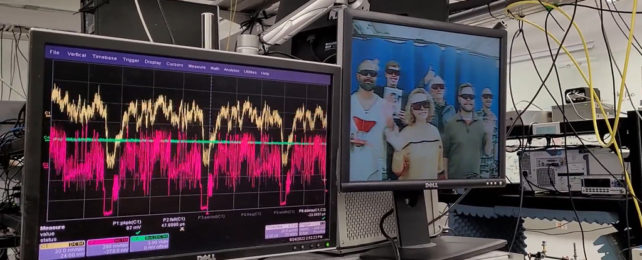Scientists have developed an 'atomic television' that uses lasers and atom clouds to carry a video signal that meets the traditional 480i resolution (480 horizontal lines) standard.
Just don't expect it to be installed as part of your home entertainment setup any time soon.
Key to the technology is a glass container of gaseous super-sized rubidium atoms excited by two colors of laser beams into what's known as a Rydberg state – that's when atoms have a high level of energy, causing the electrons to orbit further out from the nucleus.
That, in turn, makes the atoms larger and more stretched out, and it also makes them sensitive to electromagnetic fields – so they can be used as a television signal receiver. The researchers previously did a similar trick with radio signals.
"We figured out how to stream and receive videos through the Rydberg atom sensors," says electrical engineer Chris Holloway from the National Institute of Standards and Technology (NIST) in the US.
"We basically encoded [a] video game onto a signal and detected it with the atoms. The output is fed directly into the TV."
The atom cloud is first prepared using a radio signal. Its effect on the energy shifts in the Rydberg atoms is measured and used as a reference point. A video feed is then added to modulate the original signal, and transmitted via a horn antenna.
By analyzing one of the laser beams as it passes through the atoms, the scientists extract the video signal and convert it into a format suitable for a screen. The setup was previously tested using feeds from a video camera and from a video game console.
For the system to be a success, the team had to get the size of the laser beams just right. As the beam size changes, so does the time the laser light spends interacting with the atoms, which then impacts the bandwidth of the video stream.
"The beam size affects the average time the atoms remain in the interaction volume, which is inversely proportional to the bandwidth of the receiver," write the researchers in their published paper.
After tests, the team found that small beam diameters less than 100 micrometers for both lasers were the sweet spot in terms of response speed and being able to broadcast color. They were able to get impressive data rates of up to 100 megabits per second.
Researchers say that, in the future, these rates could be improved even further. The resolution of 480i looks pretty fuzzy by modern-day standards, but now that the technology is in place and working, it can be refined.
Right now, the atomic receiver is around the size of a dining table, but in the future, it should be possible to scale it down. These devices could be smaller and more versatile than existing receivers, and less easily affected by noisy environments.
What's more, the same principles could eventually be used with glass, commercially available atoms, and standard fiber optic cables. By recalibrating the lasers, the receivers would be able to quickly adapt themselves to receive audio and video signals.
"You don't have to change any electronics components or use different sockets," physicist Amita Deb from the University of Otago in New Zealand, who wasn't involved in the study, told New Scientist.
The research has been published in AVS Quantum Science.
